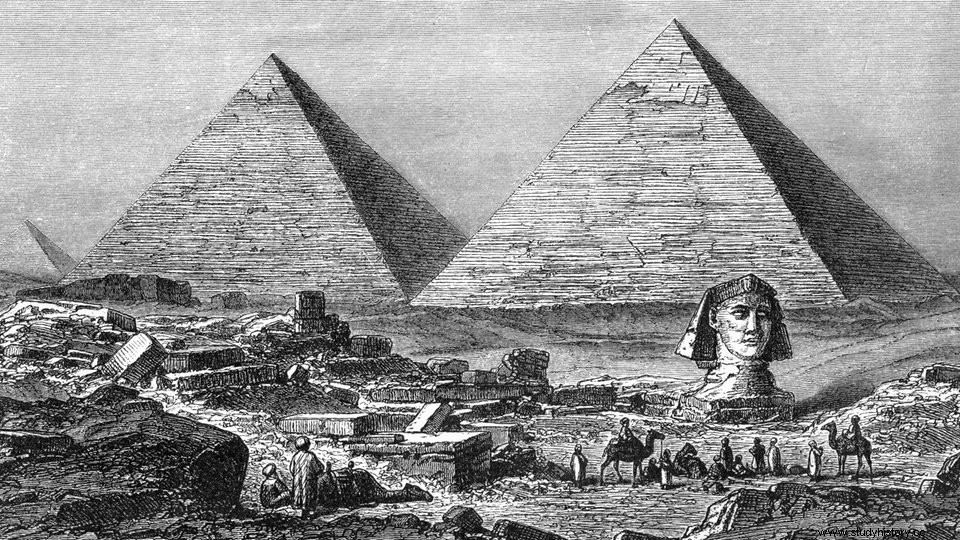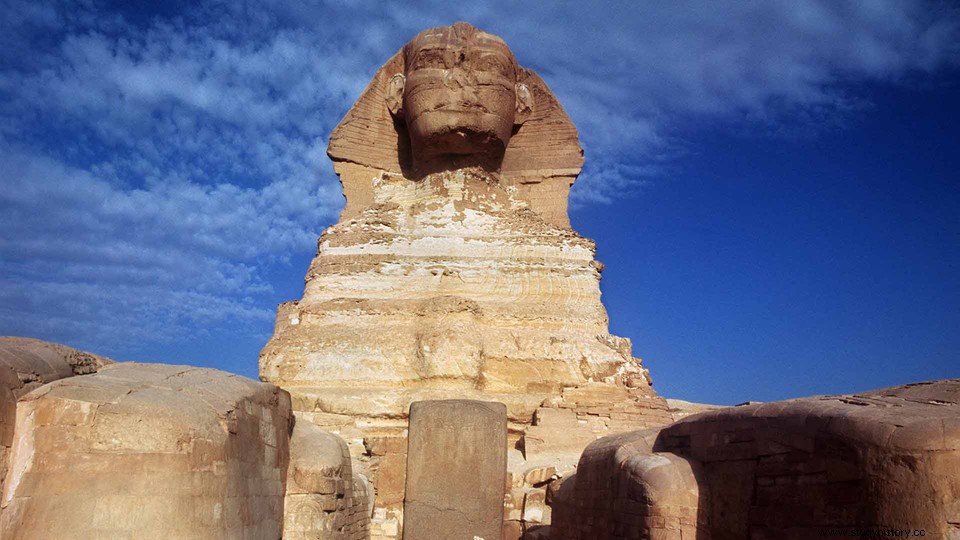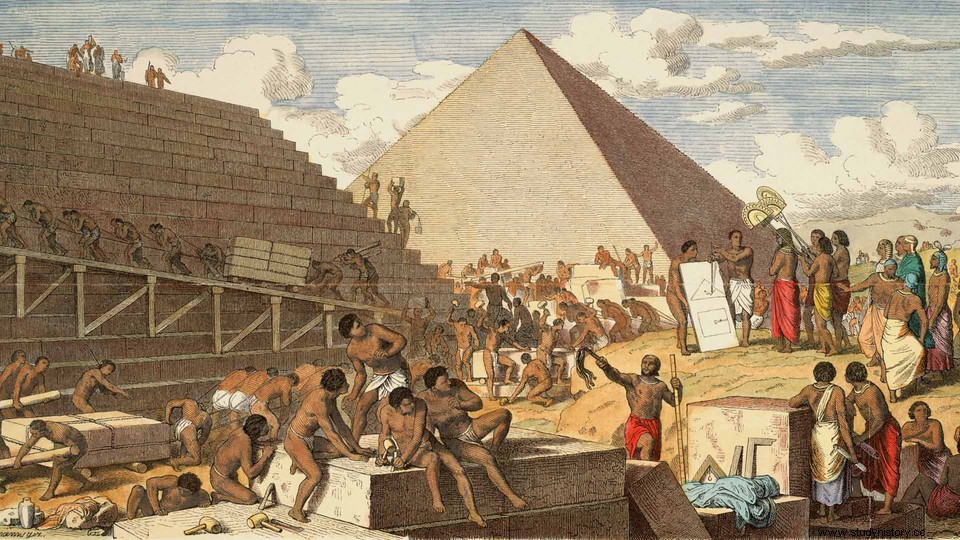Egyptian pyramids are still a myth. Scientists and engineers around the world are puzzled as to how the monumental buildings came into being around 4,500 years ago.
Encrypted knowledge
As recently as the 1970s, author Erich von Däniken believed that extraterrestrials were the originators of the pyramids. Research has long since refuted such pseudoscientific theories.
Nevertheless, the desert sands and the meter-thick walls of the pyramids still harbor enough mysteries to keep generations of scientists busy.
If a rich person were to commission the construction of a pyramid today, even the largest builders would swallow:2.6 million stone blocks with a minimum weight of 2.5 tons per block. The chunks would have to be brought in from the quarries all over Europe. The entrepreneur would be busy with the construction for more than half a decade.

How were the pyramids built?
This example, which is not meant to be taken seriously, gives an idea of what a challenge the construction of such a pyramid must have been for engineers and workers around 2550 BC. 106 pyramids run like a chain through Egypt, but their queen is the Cheops pyramid in Giza.
Before its outer skin and parts of the spire were stolen, it was 146 meters high and had a floor area of 53,000 square meters. It contains the key to the entire Egyptian architecture. If the researchers manage to elicit the secrets of the Cheops pyramid, many gaps in ancient Egyptian historiography will be closed.
Actually impossible
The construction of the Great Pyramid of Cheops at a time when people knew only simple tools compared to today still resembles a miracle even after decades of research.
A few years ago, the magazine "Der Spiegel" found a suitable comparison:"It's as if the use of fire was immediately followed by the construction of the atomic bomb."
Many things are amazing:the stone blocks of the pyramid are cut with an accuracy of 0.2 millimeters. Just a razor blade would fit between the rows of stones. The foundations of the pyramid only deviate a maximum of 16 millimeters from the horizontal and that with a lower edge length of around 230 meters.
The right angles of the corners make today's engineers green with envy:the angles are cut so precisely that even laser-assisted measuring devices could not work more precisely.
And all these engineering masterpieces are said to have come from a people who, according to some researchers, did not even know the advantages of the wheel at the time the foundation stone was laid?

How could the Egyptians build such structures?
The truth is in the details
The reason for this contradiction lies in the lack of knowledge about the state of research in antiquity. Because Alexander the Great had almost all the accumulated knowledge of the Egyptians destroyed in the 4th century BC.
The salvaged books containing the "knowledge of the ancients" burned in the library of Alexandria in the time of Caesar, in the middle of the 1st century BC.
Recent studies of the Egyptian pyramids suggest that the Egyptians had a gigantic advance in knowledge over other peoples. English researchers discovered that twice the height of the Cheops pyramid is in the same ratio to its circumference at the base as the diameter of the circle is to the circumference.
This means that the Egyptians were already working with the number pi (the ratio of a circle's circumference to its diameter) long before it was discovered in other cultures.

Storehouse of Knowledge - the Library of Alexandria
Extravagance or grandiose madness?
Why did the pharaohs build pyramids? It seems the Egyptians were a spiritually advanced people. They were cultured and had laws. It cannot be assumed that a dictatorial pharaoh could have forced a large part of his people to work on the mammoth project.
Behind the pyramids, it is believed, stood both the pharaoh and his people. The reason the pyramids were built must have been of particular importance to the Egyptians - why else would the thousands of laborers endure the rigors of a ten day, ten hour week with one day off, knowing that they would not be older than 30 to 35 years? The experts are arguing about this question.
One theory holds that the pyramids were built out of fear of the cataclysm, fear of a sudden torrential annihilation of the entire culture.
According to this theory, the Egyptians brought their entire scientific, astronomical and mathematical knowledge to the point by building the pyramids, so to speak as a journeyman's piece for society as a whole for eternity.
Other theories speak of the godlike pharaohs' craving for recognition. The people therefore believed that the pharaohs could only continue to watch over their people after their death if they managed to ascend to heaven with the help of riches for the realm of the dead and a suitable "staircase".
Less metaphysical scholars simply believe that the building of the pyramids was occupational therapy for people unemployed during Nile flood times.
While it used to be assumed that slaves had to work under terrible conditions for the pyramids, later indications were found that the workers were well paid.

The Sphinx stands in front of the Chephren Pyramid
A slightly different construction site
The researchers have not yet found a solution to one of the simplest questions:how were the Egyptians able to transport and stack the stones?
There are still various explanations, but they all have their weaknesses. The stone blocks were probably transported on wooden sledges.
The biggest problem for the architects of the Cheops pyramid was probably the granite stones for the king's chamber. Each one weighs 50 tons - too much to be pulled up with so many workers.
The first theory assumes that the Egyptians built a ramp that continued to increase as the pyramid grew. The workers are said to have used this ramp to pull the stones onto the finished plateau of the pyramid.
The problem with this theory:If you assume a gradient of five percent for the ramp, then it would have to be three kilometers long in order to place the last stones at the top at over 145 meters. There was no room for it in front of most of the great Egyptian pyramids. Such a gigantic ramp would have a volume of 20 million cubic meters - almost ten times more than the pyramid itself.
The Cheops pyramid consists of 2.6 million stones. Assuming that it was worked on for 20 years, a block should have been delivered almost every two minutes in a ten-hour working day. Even with so many workers, this is hardly imaginable over a three-kilometer ramp.

This is how construction work was imagined in the 19th century
An outer ramp
Another attempt at explanation describes an outer ramp that snakes around the pyramid, similar to a spiral staircase on the outer wall of the pyramid.
The time factor also speaks against this theory, because this ramp would also be several kilometers long after a few circuits around the pyramid.
The construction of such a ramp would require vast amounts of wood, and that was scarce in Egypt at the time, and also very expensive. Tests with a replica of the ramp also showed that the heavier blocks could not have been transported.
If the theory is correct despite all the contradictions, it could not be proven. The cladding of the pyramid has been stolen over the millennia, and with it the possible traces of such a ramp.
An explanation is needed
Another theory says that the Egyptians built their pyramids using machines (elevators, winches, cranes). The Greek historian Herodotus spoke of machines as early as the 5th century BC.
In modern research, however, this possibility has long been rejected, since workshops and work camps were found during the excavations around the pyramids, but no evidence of machines that would have been suitable for lifting and pulling such loads.
Since all other possibilities discussed have their explanatory weaknesses, many archaeologists and engineers now believe in the machine theory, even if it has not yet been proven.
A theory developed at the Institute for Egyptology at the University of Münster also rejects ramps as an explanation:According to the theory, the great pyramids like that of Cheops originally had a stepped structure, just like the smaller pyramids. Smaller steps were built into these steps and the blocks were levered up over them.
In order to obtain a smooth pyramidal surface, an intermediate layer was then applied to the step structure. But the proof for the theory is still missing.

Did the Egyptians work with machines?
